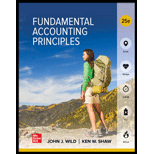
Credit card sales
Prepare
1. Sold $20,000 of merchandise, which cost $15,000, on MasterCard credit cards. MasterCard charges a 5% fee.
2. Sold $,000 of merchandise, which cost $3,000, on an assortment of bank credit cards. These cards charge a 4% fee.
Credit Card Sales:
Credit card sales refer to those sales, the payment of which is received through credit card from the customer.
Journal Entries:
Journal entries are used to record the transactions of an organization in a chronological order. Based on these journal entries, the amounts are posted to the relevant ledger accounts.
Accounting Rules for Journal Entries:
- To increase balance of the account: Debit assets, expenses, losses and credit all liabilities, capital, revenue and gains.
- To decrease balance of the account: Credit assets, expenses, losses and debit all liabilities, capital, revenue and gains.
To prepare:
Journal entries.
Answer to Problem 1QS
Solution:
Sale of merchandise on credit:
| Date | Account Title and Explanation | Post ref. | Debit($) | Credit($) |
| Cash | 19,000 | |||
| Credit Card Expenses | 1,000 | |||
| Sales | 20,000 | |||
| (Record credit card sales less 5% fee.) |
- Table (1)
Explanation of Solution
- Cash account is an asset account and it record an increase, hence it is debited.
- Credit card expenses account is an expense account, it records an increase, and hence it is debited.
- Sales account is a revenue account, it records an increase, and hence it is credited.
Working note:
Given,
Sales are $20,000.
Credit card fee is 5%.
Calculation of credit card expenses,
Calculation of cash received,
Want to see more full solutions like this?
Chapter 9 Solutions
FUND.ACCT.PRIN.
- solving this general accounting question.arrow_forwardPlease give me correct answer this financial accounting questionarrow_forwardIf there were 72,000 pounds of raw materials on hand on February 1, 195,000 pounds are desired for inventory at February 28, and 390,000 pounds are required for February production, how many pounds of raw materials should be purchased in February? a. 270,000 pounds. b. 479,000 pounds. c. 513,000 pounds d. 310,000 pounds.arrow_forward
- Heritage Cycles plans to sell6,000 electric scooters at $95 each in the coming year. The unit variable cost is $56.80 (includes direct materials, direct labor, variable factory overhead, and variable selling expense). Fixed factory overhead is $25,000, and fixed selling and administrative expenses are $40,000. 1. Calculate the variable cost ratio. 2. Calculate the contribution margin ratio.arrow_forwardPlease provide the accurate answer to this general accounting problem using valid techniques.arrow_forwardPlease explain the solution to this general accounting problem using the correct accounting principles.arrow_forward
 College Accounting, Chapters 1-27AccountingISBN:9781337794756Author:HEINTZ, James A.Publisher:Cengage Learning,Principles of Accounting Volume 1AccountingISBN:9781947172685Author:OpenStaxPublisher:OpenStax College
College Accounting, Chapters 1-27AccountingISBN:9781337794756Author:HEINTZ, James A.Publisher:Cengage Learning,Principles of Accounting Volume 1AccountingISBN:9781947172685Author:OpenStaxPublisher:OpenStax College

